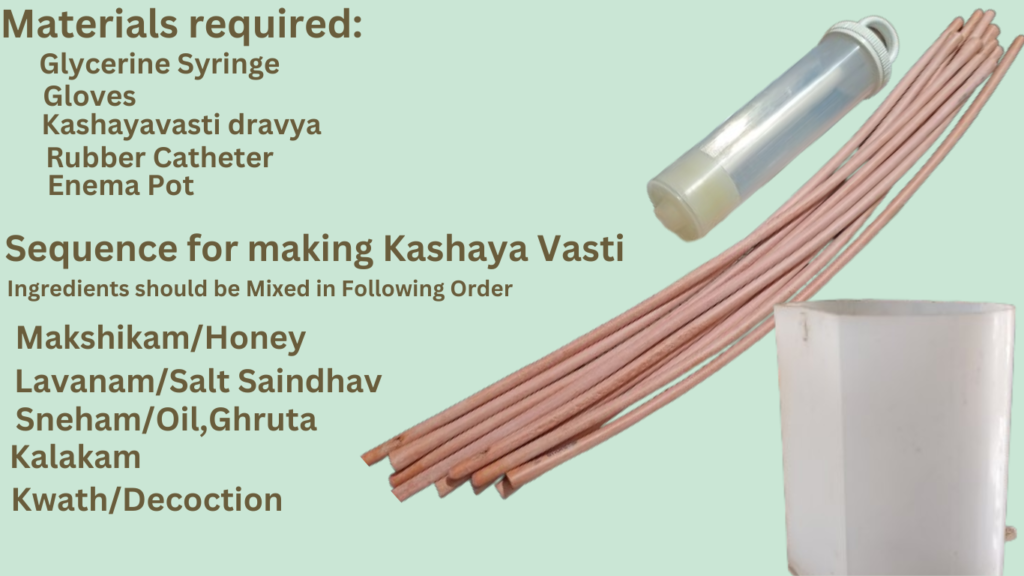Kashaya Vasti/ Asthapan Vasti
Kashaya Vasti is an integral component of the traditional Ayurvedic detoxification and rejuvenation therapy known as Panchakarma. It is also caled as Nirooha Vasti. This therapeutic procedure involves the administration of a specific decoction (kashaya) through the rectum, aiming to eliminate toxins, balance doshas, and promote holistic well-being. Asthapan Vasti specially acts on imbalanced VATA dosha. Kashaya vasti used in several neurological disorder and paralysis cases. it acts on whole body system. As the Sun absorbs the energy insummer seasons with his hot rays in same ways vasthi eleminates vata from all over body even administered through Rectal route. in Ayurveda vasti called as Ardha chikitsa in all types of disease.

Preparation of Vasthidravya:
- Initially Saindhava is put in the Khalwa yantra and it is powdered well
- Madhu is added in thin stream triturating properly to ensure a homogenous mixture.
- It is followed by the mixing of appropriate tailam in required quantity mentioned in the yoga slowly by the side of the mortar and it is continuously stirred until it attains a uniform consistency.
- The kalka, which is the fine paste of drugs mentioned in the yoga is added little by little along with proper grinding with pestle.
- Then appropriate kwatha in required amount as per yoga is added slowly and properly mixed.
- The Avapa, if mentioned in the yoga/if needed, is added at last followed by proper stirring.
- The mixture is filtered through a fine sieve and finally made lukewarm by keeping over a hot water bath.
- This mixture is churned well with the help of a churner.
Procedure Of Kashaya Vasti
Decoction Preparation: A specialized decoction is meticulously prepared by boiling medicinal herbs, plants, and other Ayurvedic ingredients. This decoction is formulated to address specific imbalances and health conditions, making each Kashaya Vasti treatment unique.
Patient Evaluation: Before administering Kashaya Vasti, an Ayurvedic practitioner assesses the individual’s constitution, health status, and any prevailing doshic imbalances. This personalized approach ensures that the treatment aligns with the patient’s specific needs.
Kashaya Vasti Administration: The prepared kashaya vasti Mixture is then introduced into the rectum using a specific enema apparatus. The enema facilitates the absorption of the therapeutic properties of the decoction, targeting the colon but effects Aapadtalmastakam ( From Head to Toe all over body) for maximum effectiveness.
Retention Period: The patient is required to retain the kashaya for a specific duration, allowing the body to absorb the medicinal properties. This helps in the elimination of toxins and the restoration of balance to the doshas.
Post-Treatment Care: Following Kashaya Vasti, individuals are guided through a post-treatment regimen that includes dietary recommendations, lifestyle modifications, and herbal supplements to consolidate the benefits of the therapy.
Benefits:
Detoxification: Kashaya Vasti aids in the removal of accumulated and aggravated Vata with toxins from the body, promoting a deep sense of purification.
Digestive Health: The procedure supports digestive function by balancing the doshas and promoting optimal gastrointestinal health.
Balancing Doshas: Kashaya Vasti is specifically designed to pacify doshic imbalances, bringing harmony to Vata, Pitta, and Kapha.
Joint and Muscular Support: It can be particularly beneficial for conditions related to joints and muscles and Neuromuscular problems providing relief from inflammation and promoting flexibility. Thus Promoting the Quality of life of critically ill and chronic condition suffering patients
Caution:
- Kashaya Vasti, like all Panchakarma procedures, should be administered by trained and experienced Ayurvedic practitioners. Individual variations in response to the therapy may occur, and it’s essential to undergo a thorough consultation before undergoing the treatment.
- This information is intended for educational purposes, and for personalized advice and treatment, individuals should consult qualified Ayurvedic practitioners.
